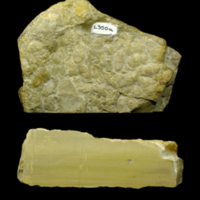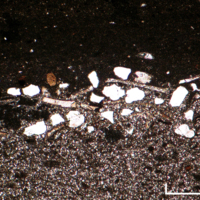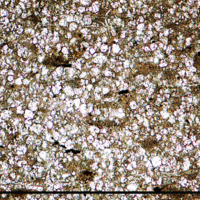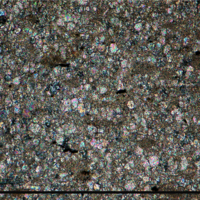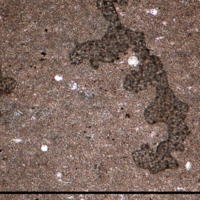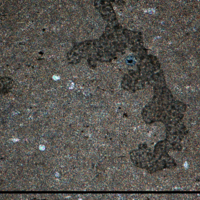- Home
- Rocks
- Type fossils
- Fossil Specimens
- Minerals
- Glossary
- Stratigraphic Chart
- Michel-Levy Chart
- Classification of igneous rocks
- University of Cambridge
- Department of Earth Sciences
- ESC Library
- Moodle
- Sedgwick Museum
- DoITPoMS
- Mindat.org
- Microfossils
- Bryozoans
- Webmineral
- Tree of Life
- CrystalMaker
- Virtual Microscope
L350 - Argillaceous limestone
Age
Jurassic
Location
Purbeck
Near Salisbury
Hand Specimen
Pale yellow-grey mudstone containing the fossil remains of a small arthropod with a segmented exoskeleton.
The rock is banded and shows some surface discolouration due to weathering.
Rock fizzes with acid, so contains carbonate.
This is a soft, though well consolidated limestone (the surface has been scratched).
Thin-section
Moving across the slide, perpendicular to the laminations, there are alternations (gradual transitions) between calcareous mudstone and argillaceous limestone. One band is rich in angular quartz grains (0.1 to 0.2 mm), and contains carbonate shell fragments.
Calcite mudstone – fine-grained mosaic of calcite, small proportion of transparent brown impurity and a few small grains of quartz.
Argillaceous limestone – even finer grained calcite mosaic, more abundant brown material (probably organic) than in the calcite mudstone.
Rock History
Low energy, aqueous environment.
Advanced Notes
The fossil remains are those of Archaeoniscus, a small crustacean (which belongs to the arthropods), of supposed freshwater origin. With this extra knowledge it may be inferred that the rock was deposited in fresh water.
Rock Name
argillaceous limestone

